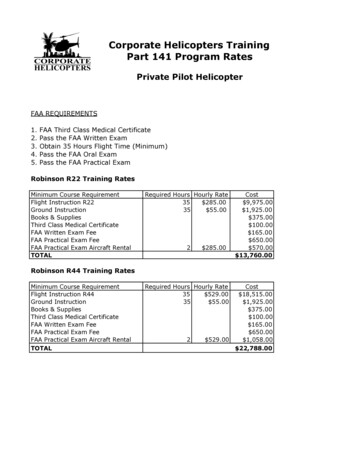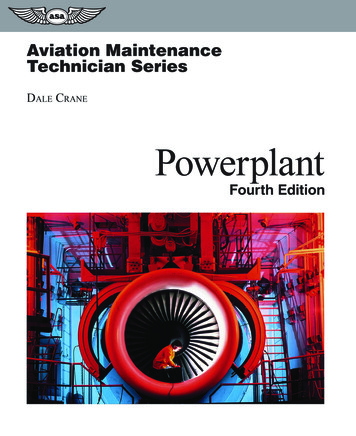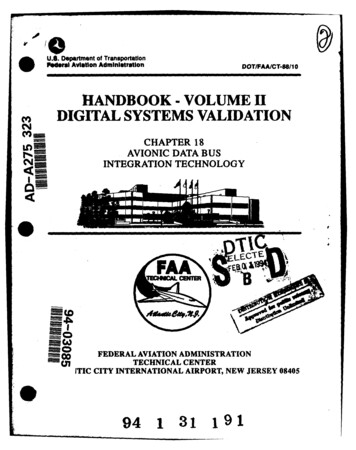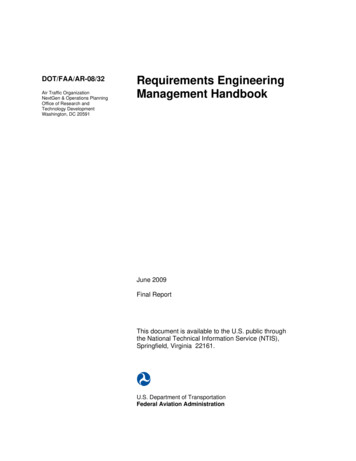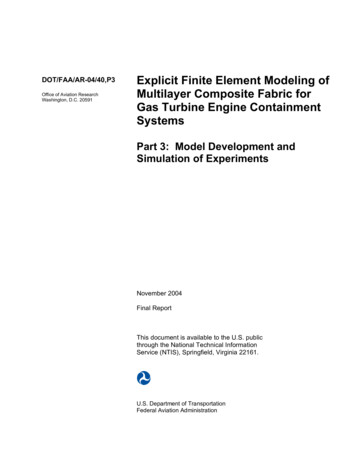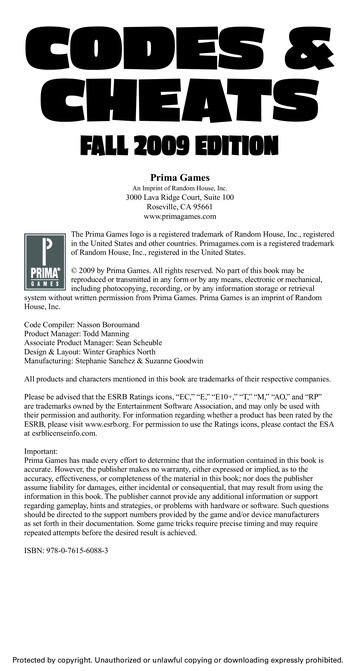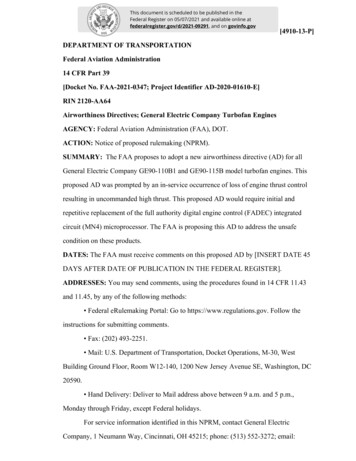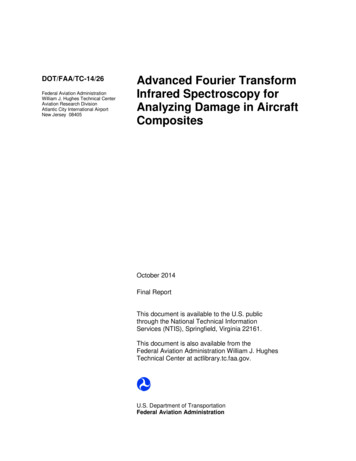
Transcription
DOT/FAA/TC-14/26Federal Aviation AdministrationWilliam J. Hughes Technical CenterAviation Research DivisionAtlantic City International AirportNew Jersey 08405Advanced Fourier TransformInfrared Spectroscopy forAnalyzing Damage in AircraftCompositesOctober 2014Final ReportThis document is available to the U.S. publicthrough the National Technical InformationServices (NTIS), Springfield, Virginia 22161.This document is also available from theFederal Aviation Administration William J. HughesTechnical Center at actlibrary.tc.faa.gov.U.S. Department of TransportationFederal Aviation Administration
NOTICEThis document is disseminated under the sponsorship of the U.S.Department of Transportation in the interest of information exchange. TheU.S. Government assumes no liability for the contents or use thereof. TheU.S. Government does not endorse products or manufacturers. Trade ormanufacturers’ names appear herein solely because they are consideredessential to the objective of this report. The findings and conclusions inthis report are those of the author(s) and do not necessarily represent theviews of the funding agency. This document does not constitute FAApolicy. Consult the FAA sponsoring organization listed on the TechnicalDocumentation page as to its use.This report is available at the Federal Aviation Administration William J.Hughes Technical Center’s Full-Text Technical Reports page:actlibrary.tc.faa.gov in Adobe Acrobat portable document format (PDF).
Technical Report Documentation Page1. Report No.2. Government Accession No.3. Recipient's Catalog No.DOT/FAA/TC-14/264. Title and Subtitle5. Report DateADVANCED FOURIER TRANSFORM INFRARED SPECTROSCOPY FORANALYZING DAMAGE IN AIRCRAFT COMPOSITESOctober 20146. Performing Organization Code7. Author(s)8. Performing Organization Report No.Alan Rein9. Performing Organization Name and Address10. Work Unit No. (TRAIS)Agilent Technologies2850 Centerville RoadWilmington, DE 1980811. Contract or Grant No.12. Sponsoring Agency Name and Address13. Type of Report and Period CoveredU.S. Department of TransportationFederal Aviation Administration950 L’Enfant Plaza North, S.W.Washington, DC 20024Final Report14. Sponsoring Agency CodeAFS-30015. Supplementary NotesThe Federal Aviation Administration William J. Hughes Technical Center Aviation Research Division COR was David Westlund.16. AbstractAircraft employing composites require advanced nondestructive testing technology to ensure the integrity of the materials ofconstruction. One of the variables that can potentially impact aircraft composites is thermal stress, which can lead to oxidation ofthe polymeric substrate of the matrix, and, in turn, potentially lead to cracks and delamination.Because composites are predominantly comprised of organic materials, analytical instrumentation can potentially provide insightinto changes occurring at the molecular level that are deleterious to composite integrity. With the recent availability of portableand mobile analytical instruments, the opportunity arises to develop new methods for nondestructively detecting chemicalchanges in aircraft composites directly where needed, on the aircraft, whether in manufacturing or during routine maintenance.This project determines the ability and effectiveness of a handheld Fourier Transform Infrared Spectroscopy (FTIR) analyzer todetect incipient thermal induced damage in aircraft composites. Changes in the composite as a function of exposure time andintensity are analyzed by the hand-held FTIR analyzer, a process that compares favorably to more established nondestructiveinspection techniques. Physical and mechanical tests benchmark the changes in strength in the composite coupons as a functionof temperature and time of exposure; the results from these mechanical strength measurements correlate quite well with the FTIRspectroscopic data. An appropriate design of experiment ensures that the range of exposures is statistically relevant andrepresentative of potential real-world situations that composite-based aircraft may experience.17. Key Words18. Distribution StatementComposites, Damage, Inspection, Fourier Transform InfraredSpectroscopy, Nondestructive inspectionThis document is available to the U.S. public through theNational Technical Information Service (NTIS), Springfield,Virginia 22161. This document is also available from theFederal Aviation Administration William J. Hughes TechnicalCenter at actlibrary.tc.faa.gov.19. Security Classif. (of this report)UnclassifiedForm DOT F 1700.720. Security Classif. (of this page)Unclassified(8-72)Reproduction of completed page authorized21. No. of Pages6422. Price
ACKNOWLEDGEMENTSImportant contributions to this work were made by Paul Shelley (Technical Fellow, The BoeingCompany), Paul Vahey (Research Chemist, The Boeing Company), Dennis Roach (SeniorScientist, Airworthiness Assurance NDI Validation Center), Paul Swindell (Research Engineer,Federal Aviation Administration (FAA)), David Galella (Project Engineer, FAA), Dirk Heider(Professor, University of Delaware Center for Composite Materials (CCM)), Joseph Deitzel(Research Associate, University of Delaware CCM), Pit Schulze (Composites Test Engineer,University of Delaware CCM), Steven Donahue (Technical Manager, Agilent Technologies,formerly A2 Technologies), John Seelenbinder (Product Manager, Agilent Technologies), FrankHiggins (Applications Engineer, Agilent Technologies), and Alan Rein (Business DevelopmentManager, Agilent Technologies).iii/iv
TABLE OF CONTENTSPageEXECUTIVE ctivesFTIR rall Experimental ConceptComposite MaterialThe DoEHeat Exposure ProcessFTIR MeasurementsThe SBS MeasurementsUltrasonic Measurements3335101316RESULTS AND DISCUSSION163.1Mechanical Tests163.2The IR Spectra of Heat-Treated Composite203.3Dependence of Spectra Carbon Fiber/Resin Ratio213.4Relationship Between Changes in Spectra and Mechanical Strength ofComposite233.5The PLS Correlation of FTIR Spectra and SBS Data233.6Neural Net Analysis of FTIR Data263.7Use of ExoScan Analyzer for Mapping Surface of Damaged Composite Panel 283.8Thermal Damage – Additional Studies in the “Transition” Range343.9BMS8-276 4″ Coupons343.10BMS8-256 4″ Coupons393.11Ultrasound and Microscopy45v
4.SUMMARY495.CONCLUSIONS516.REFERENCES52vi
LIST OF FIGURESFigurePage1The DoE42Received Composite Coupons in Drying Pan63Temperature-Monitoring Setup74Schematic of Coupon Mounting and Thermocouple (TC) Locations75Coupon Clamped in Binder Clip86Clips Mounted on Steel Rod and Profiles87Example of Temperature History During Thermal Exposure of Composite CouponsSuspended in Oven10Agilent Technologies 4100 ExoScan System Mounted in Docking Station forMeasurement of Thermal Damage in Composite Coupons119ASTM D2344 Setup on Instron 44841410Detailed View of Coupon Mounting in Test Fixture1411The SBS Strength for Both Sets of BMS8-276 Coupons1912The SBS Strength for Both Sets of BMS8-256 Coupons1913Specular Reflectance IR Spectra of Composite as a Function of Temperatureand Time Exposure20The IR Spectra of the Outer Surface of the Composite Coupon via Specular andDiffuse Reflectance21Comparison of Specular and Diffuse Reflectance IR Spectra forSanded Composite22Neural Network Architecture Used for the Evaluation of Thermally DamagedComposite Coupons27Neural Network Toolbox Output for Summarizing Predicted vs. Actual ResultsBased on FTIR Data Independent of SBS Results28Thermocouple Location2981415161718vii
19Composite Panel Lined With Tape2920Setup and Markings on Tape3021Composite Panel With Tranparencies3022ExoScan Fitted With Stand3123ExoScan Closeup3124Laser Levels3225ExoScan Laser Positioning3226Contour Maps for Thermal Damage as a Function of Distance for Panels Exposedto Increasing Levels of Thermal Stress33Thermal Damage as a Function of Position for Composite Panel Exposed to HighestLevels of Heat3328Force vs. Temperature/Time Combinations for BMS8-2763529The IR Spectra for BMS8-2763630Cluster Analysis of Spectral Data for BMS8-2763731Spectra Clustering of Low, Medium, and High Damage Within the Dataset for4″ BMS8-276 Coupons37Spectra of Composite Exposed to 490 F for Progressive Times – 30 Minutes,50 Minutes, 70 Minutes, 90 Minutes, and 120 Minutes38Spectra of 4″ BMS8-276 Coupons Exposed to 490oF for Progressive Times –30 Minutes, 50 Minutes, 70 Minutes, 90 Minutes, and 120 Minutes Overlayed WithMinimum andMaximum Thermally Exposed 1″ Coupons3934Force vs. Temperature/Time Combinations for BMS8-2564135The IR Spectra for 4″ BMS8-256 Coupons4236Cluster Analysis of Spectral Data for 4″ BMS8-256 Coupons4337Second Derivative IR Spectra Demonstrating Clustering of Low, Medium, and HighExposure in the 4″ BMS8-256 Coupons: 430 F, 50 Minutes (red); 445 F,120 Minutes (blue); 475 F, 120 Minutes (green)43273233viii
38Second Derivative Spectra of 4″ BMS8-256 Composite Coupons Exposed to 460 Ffor Progressive Times – 30 Minutes, 50 Minutes, 70 Minutes, 90 Minutes,and 120 Minutes4439Second Derivative Spectra of 4″ BMS8-256 Composite Coupons Exposed to 460 F forProgressive Times – 30 Minutes (cyan), 50 Minutes (blue), 70 Minutes (green),90 Minutes (black), and 120 Minutes (orange) Overlayed With Earlier 1″ Minimum(purple) and Maximum (red) Thermally Damaged Coupons4540A-Scan Measurement of Composite Prior to Thermal Exposure4641A-Scan Measurement of Composite After Thermal Exposure4642A-Scan Measurement of Composite After Thermal Exposure4743C-Scan Measurements of Composite Coupons: C13 Exposed to 385 F for198 Minutes; C19 Exposed to 415 F for 510 Minutes; C20 Exposed to 445 F for 510 47Minutes44Microscopic Evalution of BMS8-256 as a Funtion of Increasing Temperature andExposure Time48Summary of SBS, Ultrasound, and Microscopic Analysis of BMS8-256 Couponsas a Function of Temperature/Time Exposures48Summary of SBS, Ultrasound, and Microscopic Analysis of BMS8-276 Couponsas a Function of Temperature/Time Exposures494546ix
LIST OF TABLESTablePage1Thermal Damage Study - Temperature and Time Levels42Temperature and Time Exposures for Composite Thermal Damage Studies Based onDoE53Example Thermal Exposure Matrix for BMS8-25694Order for FTIR Measurements of BMS8-276 Composite Coupons125Example of Coupon Dimensions for BMS8-276146Average Absolute and Relative SBS Strength of BMS8-276177Average Absolute and Relative SBS Strength of BMS8-256188Results of Spectra/Mechanical Strength Correlation for BMS8-276 Evaluation Set249Results of Spectra/Mechanical Strength Correlation for BMS8-256 Evaluation Set2410Results of Spectra/Mechanical Strength Correlation for Sanded BMS8-256Evaluation Set25Results of Spectra/Mechanical Strength Correlation for Unsanded BMS8-256Evaluation Set as Measured by Specular Reflectance25Results of Spectra/Mechanical Strength Correlation for Sanded BMS8-256Evaluation Set as Measured by Diffuse Reflectance26The SBS Data for 4″ BMS8-276 Coupons, Which Were Analyzed at AANC andThen Cut Into 1″-Size for SBS Analysis at CCM34The SBS Data for BMS8-256 4″ Coupons, Which Were Analyzed at AANC andThen Cut Into 1″ Size for SBS Analysis at CCM4011121314x
LIST OF UUVAbsorbance to noiseAirworthiness Assurance NDI Validation CenterAmerican Society for Testing and MaterialsBoeing Material SpecificationCenter for Composite MaterialsDesign of ExperimentFourier Transform Infrared SpectroscopyInfraredNondestructive inspectionNondestructive testingPartial least squaresShort beam shearThermocoupleThrough-transmission ultrasoundUltraviolet radiationxi
EXECUTIVE SUMMARYAircraft employing composite materials in their construction require advanced nondestructivetesting technology to ensure the integrity of the materials. One of the variables that canpotentially impact aircraft composite materials is thermal stress, which can lead to the oxidationof the polymeric substrate of the matrix and, in turn, potentially lead to cracks and delamination.Because composites are predominantly comprised of organic materials, analyticalinstrumentation can potentially provide insight into changes occurring at the molecular level thatare deleterious to composite integrity. With the recent availability of portable and mobileanalytical instruments, the opportunity arises to develop new methods for nondestructivelydetecting chemical changes in aircraft composites, directly where needed on the aircraft, whetherin manufacturing or during routine maintenance.This project determines the ability and effectiveness of a handheld Fourier Transform InfraredSpectroscopy (FTIR) analyzer to detect incipient thermal induced damage in aircraft composites.Changes in the composite as a function of exposure time and intensity are analyzed by the handheld FTIR analyzer, a process that compares favorably to more-established nondestructiveinspection techniques. Physical and mechanical tests benchmark the changes in strength in thecomposite coupons as a function of temperature and time of exposure; the results from thesemechanical strength measurements correlate quite well with the FTIR spectroscopic data. Anappropriate design of experiment ensures that the range of exposures is statistically relevant andrepresentative of potential real-world situations that composite-based aircraft might experience.xii
1. INTRODUCTION.1.1 BACKGROUND.The prospect of using composite materials to reduce airframe weight (and, thus, enable greaterfuel economy and lower operating costs) has led to its accelerated adoption in commercialaircraft. The anticipated increased use of composites presents new challenges in maintainingsafe flying conditions. In fact, there have already been calls for improving the inspection processfor composite materials [1]. While all aircraft are subject to environmental damage, compositematerials are susceptible to environmental damage that is different from that which traditionalaluminum materials suffer. The resin component of the composite consists of organic molecules,which are susceptible to the effect of a number of external stressors, such as heat, cold, moisture,ultraviolet (UV) light, and exposure to chemicals. Analyzing the effect of these environmentalstressors on in-service composite-based aircraft requires new techniques and strategies.In 1990, Oak Ridge National Laboratory published a report [2] on several spectroscopictechniques for determining the extent of heat damage on composite panels. The study revealedthat diffuse reflectance Fourier Transform Infrared Spectroscopy (FTIR) and laser-inducedfluorescence had the highest degrees of success, but both techniques required development of afield unit that could be used for nondestructive inspection (NDI). Late in the 1990s, a mobileFTIR system designed for the field analysis of composites was developed. However, this systemweighed 20 pounds and had ergonomic limitations with respect to inspecting non-flat compositesor composite locations that were less accessible.In 2008, a 7-pound battery-powered FTIR analyzer was introduced. The ExoScan system(developed by Agilent Technologies, formerly A2 Technologies) is equipped with samplinginterfaces that permit the nondestructive analysis of optically opaque materials, such as the midmodulus, carbon fiber resin composites that are used by the aerospace industry.On September 18, 2008, the Federal Aviation Administration awarded a 3-year research contractto A2 Technologies (now part of Agilent Technologies) to determine the value and feasibility ofemploying this handheld, battery-operated FTIR as a new non-destructive testing analyzer forcomposite-based aircraft. The collaborators on this project are A2 Technologies, the Universityof Delaware Center for Composite Materials (CCM), the Airworthiness Assurance NDIValidation Center (AANC) at Sandia National Labs, and The Boeing Company.1.2 OBJECTIVES.The main project objective is to determine if the ExoScan FTIR system can detect incipientthermal damage in aircraft composites. To accomplish this, coupons of composites used incivilian aircraft manufacture were exposed to varying temperature and time combinations.Changes in the composite as a function of exposure time and intensity were measured by thehandheld FTIR analyzer and established NDI techniques. Physical and mechanical tests wereused to benchmark the changes in strength in the composite coupons; the results from thesemechanical strength measurements have been correlated with the spectroscopic and NDI results.A Design of Experiment (DoE) was developed to ensure that the range of exposures was1
statistically relevant and representative of potential real-world situations that composite aircraftmight experience. The primary questions and objective to be investigated in this research projectwere: Does FTIR, a nondestructive surface method, detect chemical changes in composites thatmay relate to changes in the overall strength (a bulk property) of the composite? If so, can a reliable FTIR method be developed that rapidly elucidates change incomposite strength induced by thermal affects? Can trained nondestructive testing(NDT) operators routinely execute the method and deliver reliable results? What is the relevance of FTIR as an NDI method for composites, and how does itcompare to more commonly used NDI methods? Work with third party to calibrate and validate the ExoScan technology for use indetecting heat damage in composite-based aircraft.1.3 FTIR SPECTROSCOPY.FTIR spectroscopy is a widely used analytical method and FTIR spectrometers are present invirtually all industry and academic laboratories. The primary use is to provide information aboutmolecular identity and structure as defined by patterns of characteristic absorbance bands,primarily measured in the 4000 cm-1 to 500 cm-1 (2.5–20 microns) region of the spectrum.The position and intensity of these characteristic absorbance patterns are directly related tointeratomic vibrations in the molecules and, thus, are diagnostic for the identity and quantity ofspecific molecules present in a sample.An FTIR spectrometer contains an infrared (IR) source, interferometer, and IR energy detector.In its simplest form, the interferometer consists of a beamsplitter, fixed mirror, and constantvelocity moving mirror. IR radiation from the source is split into two components by thebeamsplitter then recombined, passed through a sample, and delivered to the detector. Themoving mirror creates a pattern of constructive and destructive interference of all thewavelengths of IR radiation simultaneously. This pattern of interferences is called theinterferogram. When the radiation from the interferometer is passed through a sample, some ofthe wavelengths of energy are absorbed by the molecules, resulting in an altered interferogram.This molecule-specific interference pattern is then converted from the time-distance domain tothe frequency domain using a Fourier transform algorithm, resulting in the familiar andcharacteristic IR spectrum of the sample.2
2. APPROACH.2.1 OVERALL EXPERIMENTAL CONCEPT. Via the DoE, expose composite materials to a range of variables (e.g., time, temperature,intensity of exposure, etc.) to induce thermal, UV, or chemical damage. Measure the damage using IR spectroscopy and “gold standard” NDI, as well as physicalmethods. Determine the best IR sampling method for both fiber-poor (composite surface) andfiber-rich (subsurface, via sanding) sections of composite. Establish correlation between IR results and data provided by NDI/physicalmeasurements. Based on the above correlations, develop methods/protocol for use of IR analyzertechnology by NDT technicians.2.2 COMPOSITE MATERIAL.The Boeing Company provided the epoxy resin composite materials for this project. Twodifferent composites were chosen: 1) Boeing material specification (BMS) 8-276, used in thefuselage of the Boeing 787 airliner and 2) BMS8-256, used in the vertical tail fin assembly of theBoeing 777 airliner. Large panels of the composites were prepared from prepreg at Boeing.After curing, these composite panels were examined by through-transmission ultrasound (TTU)to ensure integrity. The dynamic range was 140 dB (tone-burst), using a water jet TTU scansystem with 5Mhz scans. These panels were then cut into small coupons, which wereapproximately 0.18″ thick (24 ply) x 0.36″ wide x 1.08″ long.Several 12″-square panels of the two composites were prepared to be used for mapping studies.These studies were intended to determine whether the FTIR system could measure the pointwhere pristine composite ends and damaged composite begins on a larger surface and, thereby,map the extent of damage.Additionally, sixty-three 4″ x 4″ coupons for each of the two composites were fabricated atBoeing. These coupons were used for more thorough evaluation in the transition region betweenundamaged and damaged composite material.2.3 THE DoE.Based on discussions with Boeing, a series of temperature and time levels were selected for thisproject (table 1), which were considered representative of actual conditions to which thecomposite could be exposed. The DoE (figure 1) called for 40 combinations of time andtemperature exposure to generate the samples required for thoroughly evaluating the FTIR-basedmethod for predicting thermal damage. A total of 240 coupons were prepared for each of thetwo composites to carry out triplicate measurement by both FTIR and the reference short beam3
shear (SBS) measurements. A portion of these coupons were used for developing thecalibrations that correlate the IR spectra to thermally induced mechanical damage; the remainderwas used for validating the methods. Additionally, 10 coupons, each 4″ x 4″ x 0.18″, wereexposed to varying time and temperature combinations to enable additional NDI tests.Table 1. Thermal Damage Study Temperature and Time LevelsLevelsVariableTemperature( F)Time(minutes)1020304050607008325 000355 000385 alidation32100123654Level--Temperature789Figure 1. The DoESpecific time and temperature exposure combinations (table 2) were used for the thermal damageinvestigations. Samples marked with an asterisk are the thermal exposure conditions for the 4″coupons, which were used in the additional NDI investigations.4
Table 2. Temperature and Time Exposures for Composite Thermal Damage StudiesBased on DoESample tion SetTemperature( 318.05318.05318.05510.00510.00510.00Sample #12345678*91011121314151617*1819*20Evaluation SetTemperature( 318.05318.05318.05510.00510.00510.002.4 HEAT EXPOSURE PROCESS.The thermal exposure of the test coupons was conducted at the University of Delaware CCM.The following process was followed to ensure the reliable exposure of the composite to thetemperature and time variables: Reception of samples:– 350 machined prepreg composite coupons were received from Boeing.–Coupons were sized for SBS tests (thickness 0.1875″, width 0.375″,length 1.125″)5
–Coupons were dried at a constant temperature of 125 F in a convection oven(figure 2) for 24 hours (coupon weight was monitored; no continuing weight losswas observed after 12 hours).Figure 2. Received Composite Coupons in Drying Pan Thermal exposure process:–Coupons were exposed to heat in a medium-sized convection oven(Lindberg/Blue M MO1450A) for even temperature distribution.–The temperature was monitored with four NIST-certified J-type thermocouples(TCs) (OMEGA Eng. 5SC-GG-J-30-36) and a National Instruments 9211AUSB-TC module (figure 3) using LabView Express software.6
Figure 3. Temperature-Monitoring Setup–The temperature measurements were acquired in various locations inside theoven—under/above the coupons and on the steel profiles (figure 4).Figure 4. Schematic of Coupon Mounting and Thermocouple (TC) Locations–The coupons were clamped by metal binder clips and protected by a layer ofKapton tape to eliminate surface contact and interaction between coupon andclip (figure 5).7
Figure 5. Coupon Clamped in Binder Clip–The binder clips were hung from 12″ steel rods, situated upon steel U-profiles(figure 6).Figure 6. Clips Mounted on Steel Rod and Profiles–After completion of the exposure time (table 3, figure 7), the oven was poweredoff and coupons were left inside to cool down slowly.–This process was followed for both BMS8-256 and BMS8-276 coupons.8
Table 3. Example Thermal Exposure Matrix for BMS8-256Calibration Set3853000CouponLabelC1-1 to -624453000C2-1 to -624753000E2-1 to -635053000C3-1 to -635353000E3-1 to -6441548.11C4-1 to -6438548.11E4-1 to -6547548.11C5-1 to -6544548.11E5-1 to -6653548.11C6-1 to -6650548.11E6-1 to -6738577.14C7-1 to -6735577.14E7-1 to -6844577.14C8-1 to -6947577.14E9-1 to -6950577.14C9-1 to -611445123.690E11-1 to -610355123.700C10-1 to -6841577.14E8-1 to -611415123.700C11-1 to -610385123.70E10-1 to -612475123.69C12-1 to -614475198.34E14-1 to -613385198.30C13-1 to -612355198.30E12-1 to -614445198.34C14-1 to -615325318.05E15-1 to -615355318.10C15-1 to -613415198.30E13-1 to -617475318.05C17-1 to -617445318.05E17-1 to -61832551000C18-1 to -61835551000E18-1 to -61938551000C19-1 to -61941551000E19-1 to -62044551000C20-1 to -62047551000E20-1 to -6Sample #1TemperatureTime[ F][minutes]Evaluation Set9Sample #1Temperature[ F]Time[minutes]4153000CouponLabelE1-1 to -6
Figure 7. Example of Temperature History During Thermal Exposure of Composite CouponsSuspended in Oven2.5 FTIR MEASUREMENTS.All measurements were carried out using a 4100 ExoScan (figure 8) handheld FTIR analyzer(Agilent Technologies, formerly A2 Technologies, Danbury CT). Data were recorded at both 4cm-1 and 8 cm-1 resolution; 75 and 120 interferograms, respectively, were co-added to producethe IR spectra. The spectra were recorded in the fingerprint region (i.e., from 1800 cm-1 to650 cm-1) using both 45-degree external reflectance and diffuse reflectance sampling interfaces.Composites were analyzed by FTIR in both the resin-rich region (surface of the compositecoupon) and the resin-poor region (approximately 8 mm of the surface was removed via millingto reveal the fiber-rich region).10
Figure 8. Agilent Technologies 4100 ExoScan System Mounted in Docking Station forMeasurement of Thermal Damage in Composite Coupons (docking station enablesanalyzer to be used in lab for methods development)The procedure for examining a particular time/temperature sample set via FTIR was as follows:1.The background was collected using the gold diffuse reflectance reference cap.2.Coupons were placed on the ExoScan with the center of the coupon over the samplingwindow.3.The coupon was oriented for maximum energy as measured by the centerburst intensityof the raw interferogram.4.The spectrum was collected at the desired acquisition parameters.11
5.The left end of the coupon was moved over the sampling window, maintaining theoptimum orientation.6.The spectrum was collected at the desired acquisition parameters.7.The right end of the coupon was moved over the sampling window, maintaining theoptimum orientation.8.The spectrum was collected at the desired acquisition parameters.9.Steps 2 through 8 were repeated for the second and third replicate coupons.The entire set of 4 cm-1 resolution measurements were made first, followed by the entire set of8 cm-1 resolution measurements. The order of samples (depicted in table 4) was randomizedusing the Matlab function randperm, which provides random permutations of a set of integers,in this case 1 to 40. This process was followed for both BMS8-276 and BMS8-256 coupons.Table 4. Order for FTIR Measurements of BMS8-276 Composite CouponsMeasurement Order1234567891011121314151617181920214 cm-1, 75 6E17E20C8128 cm-1, 120 C5E9E1E5
Table 4. Order for FTIR Measurements of BMS8-276 Composite Coupons(Continued)Measurement Order222324252627282930313233343536373839404 cm-1, 75 E148 cm-1, 120 0C12C Calibration, E Evaluation2.6 THE SBS MEASUREMENTS.Measurements were carried out at the University of Delaware CCM using an Instron 4484system (figure 9) equipped with an SBS fixture (figure 10). Exact coupon dimensions wererecorded and the mechanical tests carried out according to the American Society for Testing andMaterials (ASTM) D2344 standard procedure (table 5). The span length was 0.725 inches and acrosshead speed of 0.05 inches/minute was used.13
Figure 9. The ASTM D2344 Setup on Instron 4484Figure 10. Detailed View of Coupon Mounting in Test FixtureTable 5. Example of Coupon Dimensions for Sample Group14StDev
Table 5. Example of Coupon Dimensions for BMS8-276 (Continued)WidthSample GroupThicknessArea2FsbsStDev[in.][in.][mm 0.178841.180.55.0E50.35
This project determines the ability and effectiveness of a handheld Fourier Transform Infrared Spectroscopy (FTIR) analyzer to detect incipient thermal induced damage in aircraft composites. Ch
